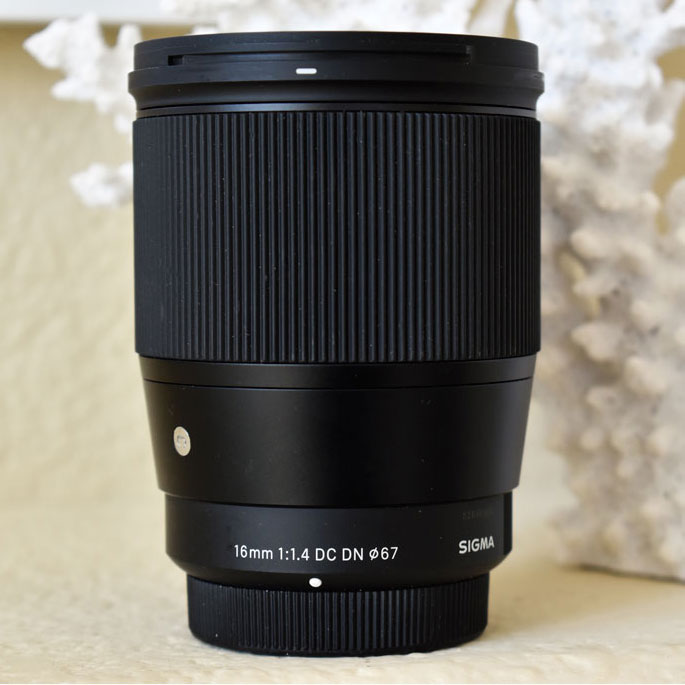Today’s Post by Joe Farace
 Sometime in the early 1970’s I bought a new Nikon F2 and in those days, you typically purchased a camera with a 50mm lens. The next lens added to my Nikon system was one I’d longingly pressed my nose against the window of Ritz Camera’s Baltimore Street store, the Sigma 16mm f/2.8 with built-in filters. I loved that lens and here we are all these years later and I’m looking at another Sigma 16mm lens, this time it’s the f/1.4 DC DN Contemporary lens for mirrorless cameras.
Sometime in the early 1970’s I bought a new Nikon F2 and in those days, you typically purchased a camera with a 50mm lens. The next lens added to my Nikon system was one I’d longingly pressed my nose against the window of Ritz Camera’s Baltimore Street store, the Sigma 16mm f/2.8 with built-in filters. I loved that lens and here we are all these years later and I’m looking at another Sigma 16mm lens, this time it’s the f/1.4 DC DN Contemporary lens for mirrorless cameras.
The lens I tested was in Micro Four-thirds mount but it’s also available for other mounts including Sony E, Fujifilm X and Canon’s now defunct E-M—more on that mount in a coming post. I decided to shoot it with my Olympus and Panasonic mirrorless cameras.
Lens Test
 To control color fringing and aberrations, the lens’s optical design uses three FLD elements, two SLD (special-low-dispersion) elements and two molded aspherical elements for sharpness throughout the aperture range. Individual elements have Sigma’s Super Multi-Layer Coating to suppress flare and ghosting. At my lens test wall o’bricks, the Sigma 16mm f/1.4’s performance was impressive. Even at f/1.4 the lens is tack sharp corner-to-corner with only the slightest hint of vignetting in the corners that’s gone by the time you get to f/2. At f/8 you are totally in the lens’s sweet spot with remarkable sharpness for the lens’s $394. price point.
To control color fringing and aberrations, the lens’s optical design uses three FLD elements, two SLD (special-low-dispersion) elements and two molded aspherical elements for sharpness throughout the aperture range. Individual elements have Sigma’s Super Multi-Layer Coating to suppress flare and ghosting. At my lens test wall o’bricks, the Sigma 16mm f/1.4’s performance was impressive. Even at f/1.4 the lens is tack sharp corner-to-corner with only the slightest hint of vignetting in the corners that’s gone by the time you get to f/2. At f/8 you are totally in the lens’s sweet spot with remarkable sharpness for the lens’s $394. price point.
On an MFT camera, the 16mm f/1.4 produces a 32mm-equivalent field-of-view. This lens uses a stepping AF motor for still photography and video. In my initial photography of the O’Brien Park gazebo and walking up and down Mainstreet shooting random subjects, focusing was fast and seamless; just touch the shutter button and bang zoom it was in focus.

How I made this photograph: This is a different and closer view of the O’Brien Park gazebo than I typically shoot during a lens test. The camera used was a Panasonic Lumix GH4 with a Program mode exposure of 1/500 at f/10 and ISO 200.
The lens has a 67mm filter thread and while the well-made lens hood that’s included provides some protection, if this was my personal lens, I’d also spring for a UV filter for additional protection. That nicely made hood can be difficult to remove from reverse storage on the lens, while the equally well-made rear lens cap is easy to remove and occasionally removed itself. Don’t lose it.
In the my post, ‘A Trifecta of f/1.4 Mirrorless lenses from Sigma,’ I mentioned that these Sigma f/1.4 lenses are “hefty” and at 14.3-oz the 16mm lens is the heftiest of the three. I mounted it on a Panasonic Lumix GH4 with battery grip and while the lens felt balanced there’s no denying it’s a serious package for a typically lightweight system like Micro Four-thirds. Part of that heft has to do with the lens’s weather-sealed and durable construction. Unlike many affordable lenses that have plastic lens mounts, the Sigma’s mount is solid brass. The 16mm f/1.4 is constructed with a combination of Thermally Stable Composite material and metal and is designed for use in a wide range of temperatures.
If you enjoyed today’s blog post and would like to buy Joe a cup of Earl Grey tea ($2.50), click here. And if you do, thank so very much.